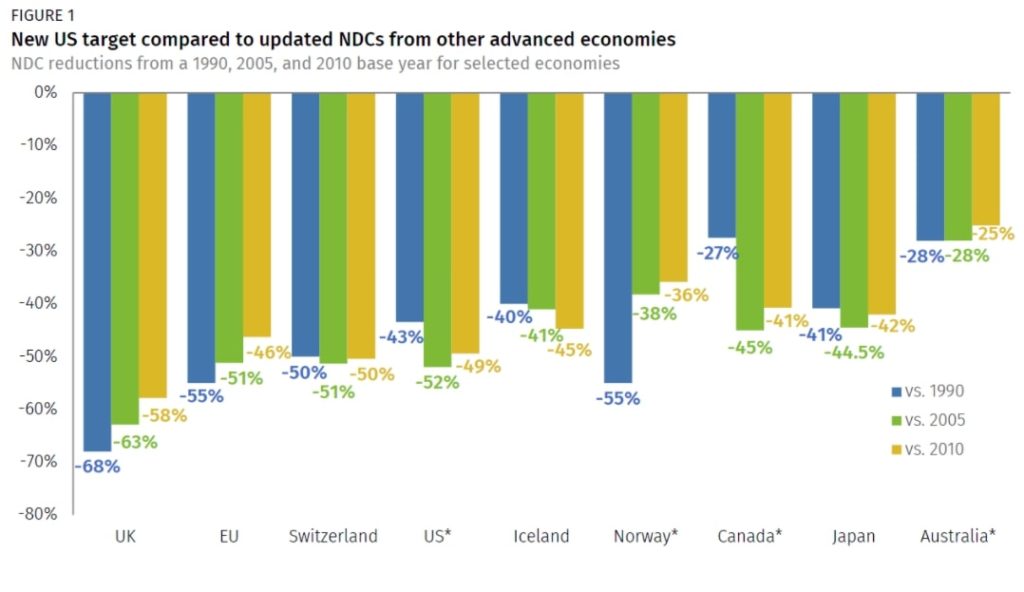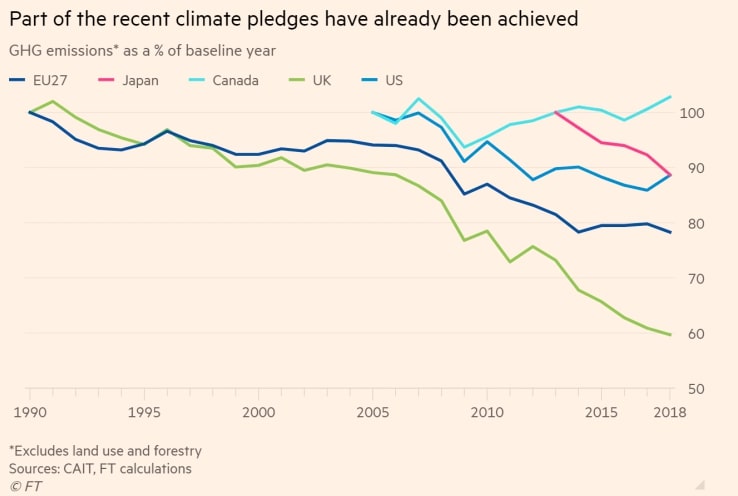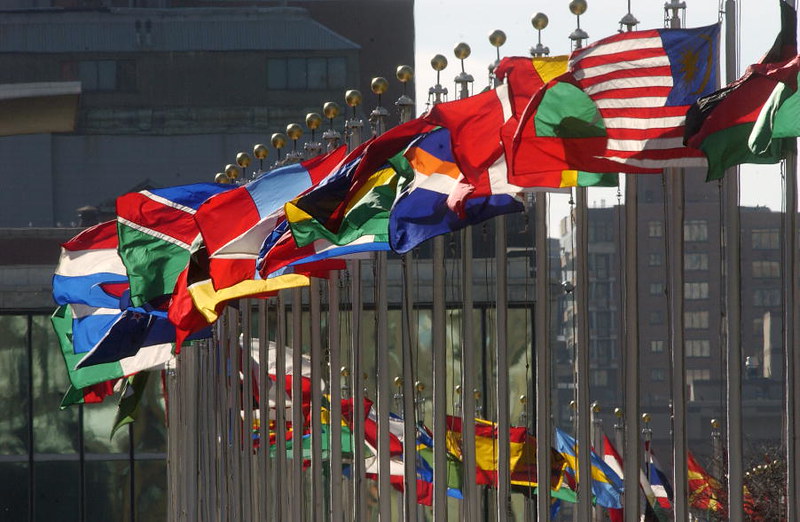Which country is doing the best at reducing its emissions? Is it the UK, with its highly ambitious goal to reduce emissions by 78% before 2030? Is it Germany, which has just brought forward its target date to achieve carbon neutrality to 2045? Or could it be China, which leads the world in renewable energy production and is unmatched in domestic and overseas investments in green technologies? The answer is actually quite complicated, since all of these countries have outlined different metrics and indicators of success in their individual climate policies. Differences between countries’ climate pledges make it difficult to compare their commitments against each other, but more importantly, they can confuse the public and distort targets to appear much more ambitious than they actually are.
—
When representatives from 174 countries gathered in New York City on April 22 2016 to ratify the Paris Agreement, it represented the culmination of several decades’ worth of disagreements over how the burden of reducing emissions should be divided amongst states.
Wealthy nations have been locked in a long-standing debate with less developed countries over how much each state should be considered responsible for global emissions, and to what extent they should be expected to reduce them. Many developing nations only industrialised decades after wealthier, mostly Western states had done, meaning that they began burning fossil fuels and generating emissions much later. These developing nations argue that they should be held to a different standard than a country such as the US, which is singularly responsible for one quarter of global cumulative emissions, historically generating more emissions than any other country.
The concept of intended and official Nationally Determined Contributions (NDCs) emerged, first proposed in their modern form at the 2011 Durban Climate Conference in South Africa, and fully established and defined by the time of the Paris Agreement’s signing in 2015. NDCs are designed to reflect what a country is capable of contributing to global emissions reductions, taking into account their wealth, responsibility for current and historical emissions and stage of development. No NDC is meant to be equal, but the goal is to have them all lined up in a way that makes the world compatible with the Paris Agreement’s goal to keep global temperature rise below 1.5°C by 2100.
NDCs are intended to be independently designed and reflective of what a country has the capacity to achieve. Countries are also expected to be continuously updating their NDCs in response to global developments or changes in their own capacity to reduce emissions, and herein lies a key intended mechanism of the Paris Agreement. NDCs were always meant to pressure rivals of similar economic capacity to match or outdo each other’s commitments. Since neither the Paris Agreement nor adhering to the terms of one’s own NDC are legally binding, peer pressure and a culture of accountability were always meant to be critical to the system’s success.
This represented an important juncture in how the world would decide to counter the climate crisis. The architects of the Paris Agreement were hopeful that this new collectivist yet individualised approach to climate change would be more effective than any centralised edict mandated by a singular authority could be.
While the jury is still out on whether this format is the best way to organise global action to reduce emissions, individualised NDCs that are designed and set by governments themselves have become a growingly confusing and incoherent array of targets defined by varying metrics. Different countries utilise different baseline years, have different indicators of success and despite the Paris Agreement clearly calling for net-zero emissions by mid-century, there is no requirement for countries to lay out a coherent set of strategies to achieve this target, nor to make these targets legally binding.
At best, inconsistencies between NDCs and climate pledges by country can be confusing and overcomplicated, discouraging people from becoming actively involved in their country’s push to reduce emissions. At worst, a state could select a politically convenient baseline year to announce a seemingly ambitious NDC, which in reality would accomplish little in lowering that country’s emissions in the long term.
How NDCs Can Differ
At the April 2020 Leaders’ Summit on Climate, convened by US President Joe Biden, countries around the world announced or reiterated targets to reduce emissions by 2030. Japan committed to a new NDC to cut emissions 46-50% below 2013 levels, South Korea reiterated a commitment to cut emissions 24.4% below its 2017 level, the EU announced a new target to reduce emissions by 55% compared to 1990 levels and the US of course pledged to achieve a 50-52% reduction relative to 2005 levels.
What is striking about these four commitments is that each country has selected a different baseline year, the year that a country selects as a point of reference in time against which future emission reductions will be measured. While there are several reasons as to why countries would opt to use different baselines, it makes it difficult to ascertain who is putting in the most effort and who is not doing enough.

Figure 1: 9 NDCs from advanced economies and equivalencies with 1990, 2005 and 2010 baselines; Rhodium Group & UNFCCC; 2021.
Climate Pledges- Baseline Year
The EU and the UK have relied on using 1990 as a baseline year because that is when the bloc began to implement its first climate policies. 1990 was also the year that the Intergovernmental Panel on Climate Change (IPCC) released its first report on the potential severity of the crisis and advised governments to begin taking action.
Other countries have selected years when their emissions peaked and have been in a primarily downward trend since. The US and Canada, which employ 2005 as a baseline year, both saw their emissions peak around 2007. Japan utilises a 2013 baseline, largely because its emissions had reached unprecedentedly high levels between 2013 and 2014. South Korea’s emissions are not expected to peak until 2020-2025, which is why the country selected an unusually late 2017 baseline.
Selectively choosing a baseline year can make climate pledges seem more or less ambitious than they actually are. For instance, the US’s new NDC is to reduce emissions by 50-52% relative to 2005 levels. But if the US had opted to use 1990, the same baseline year as the EU, the same drop in emissions would equate to only a 41% emissions cut. These selections illustrate an inherent problem with allowing states to independently choose the parameters for their NDCs. Countries select baseline years to make their emission reductions look as impressive and ambitious as possible, often masking transgressions or outlying factors.
The case of Japan is a good example. In 2013, the country had registered its highest rate of emissions at that point, 10.8% higher than 1990 levels. But the reason behind this stark increase was rooted in controversial policy decisions. Following the 2011 Fukushima Daiichi nuclear incident in Japan, the government reacted aggressively by either suspending or shutting down its nuclear power generation infrastructure. By 2014, nuclear’s share of electricity generation in Japan had dropped from 29% to zero. In response, Japan heavily increased the share of coal in its energy mix to replace nuclear power and meet the country’s electricity generation needs. Coal’s presence in Japan been rising steadily since 2011, hitting a historical record in net imports in 2018.

Figure 2: Japan electricity production 1985-2017. In 2010, coal provided 313TWh of electricity and nuclear 292TWh. In 2014, coal provided 353TWh and nuclear zero; Carbon Brief; 2018.
Japan’s policy decisions to expand coal use after 2011 became intractable and difficult to reverse or deviate from. By selecting a 2013 baseline year, and not one prior to 2011, Japan ostensibly absconded itself of the responsibility to fully address the price of the country’s own decision to increase the share of coal in its energy mix in the intervening years.
Similar issues lie with many countries who independently select their baseline years. If the reference point is when a country was at peak emissions, they could conceivably set a relatively low reduction target and still look as if they are making significant progress, neglecting any policy decisions that contributed to increased emissions before they peaked. Niklas Höhne, founding partner of the non-profit think tank NewClimate Institute, recently told the Financial Times: “For some countries, there’s some element of [manipulation]. The US has used the base year 2005 because that’s the year with the highest emissions, [from which] you get the highest reduction. There’s a natural tendency to propose [targets] in the way that makes it look positive.”

Figure 3: Reduction in GHG emissions as a percentage of baseline years in five jurisdictions; Financial Times; 2021.
Climate Pledges- Metric
Another major difference between NDCs is the metric that countries use to assess their performance. While most NDCs outline absolute emission reduction targets, some major emitters, including China and India, have instead opted to employ carbon intensity reduction targets. While the former only assesses to what extent a country has been able to bring down its emissions, carbon intensity targets refer to a reduction of emissions per unit of GDP growth, which means that a country could still have an untenably high rate of emissions as long as its economy continues to grow accordingly. Even though China and India successfully reduced their emissions as a ratio of economic output, due to their significant economic expansion since a shared 2005 baseline year, absolute emissions in both countries have increased by over 70%.
Carbon intensity targets can be useful to assess how developing countries are balancing their economic growth with decarbonisation plans, but they undeniably make comparisons with countries possessing absolute reduction targets difficult. Additionally, for countries such as China and India, which are respectively the highest and third highest global emitters, carbon intensity targets are simply unfit to reach the emission reductions needed from these actors.
Other factors, including historical emissions, per capita emissions and whether or not a country has made their climate target legally binding make comparing pledges complicated, to the point where institutional accountability might falter. Peer pressure and accountability were designed to be critical mechanisms to the Paris Agreement’s functioning, but accountability becomes difficult to enforce if there is no value of reference one country can use to evaluate another’s performance.
So far, fortunately, peer pressure appears to be working, given the spate of ambitious announcements that emerged from Biden’s climate summit. But effective climate diplomacy and international cooperation to find solutions to the climate crisis will be hampered if countries can mask their shortcomings with flattering yet misleadingly designed NDCs.
Bloated Ambitions of Climate Pledges
The lack of a clear standard by which to define and construct an NDC leaves openings for nations to behave in opportunistic and self-aggrandising ways, conflating numbers, mathematics and policy to make it appear as if they are taking sufficient action.
This unfortunate behaviour was displayed by certain attendees at Biden’s summit. Countries which are doing woefully little to meet their responsibilities to tackle climate change and reduce global emissions made announcements and pledged targets that were not only insufficient, but outright misleading and confabulated with politically convenient numbers.
During Australian Prime Minister Scott Morrison’s remarks at the summit, the politician made a series of confusing statements that masked Australia’s notoriously weak climate policy. Morrison claimed that the country had already reduced emissions by 19% compared to 2005 levels, and that it was rapidly outpacing other similarly advanced economies. A few minutes later, the PM contradicted himself by stating that domestic emissions had fallen by 36%.
The true number is actually closer to 16%. While it is unclear where Morrison retrieved the 19% value from, the 36% emissions reduction claim was achieved by excluding the environmental cost of Australia’s exports. What this means is that whenever Australian commodities are sold abroad, the emissions generated by the extraction, production and refinement of these are applied to the destination country. This tabulation leaves out the costs of Australia’s liquified natural gas (LNG) industry, which has grown tremendously in recent years. The emissions generated by Australia’s LNG production are enough to effectively cancel out the emission reductions from electricity generation in the country as consumers have progressively shifted to wind and solar.
Morrison’s statements have been called a “Trumpian misrepresentation” of the data by analysts, and the PM’s behaviour at the Leaders’ Climate Summit is representative of an important and potentially consequential drawback to the Paris Agreement’s structuring. With the way the treaty was structured, countries do not need to build their climate pledges with baseline years or indicators that represent the work they actually need to do to meet their fair share of reducing global emissions. Rather, states can take the opportunity to select metrics and parameters that are largely based on political motivations to make a country seem more ambitious than it actually is.
This quirk of NDCs and climate pledges has not been lost on global leaders. In early May 2021, at the St. Petersburg Climate Dialogue, Chancellor of Germany Angela Merkel said: “It would be good if we could all actually agree on the same kind of base that we start from, the yardstick by which we judge our progress… [countries] ought to come to an agreement there.”
The architects of Paris believed that peer pressure would be the most effective- and least disruptive- way to coerce countries into establishing progressively more ambitious commitments to reduce their emissions. Whether that will prove to be an effective strategy or not remains to be seen, but the lack of a shared reference point and the ability of states to set their own parameters has certainly created ideal opportunities for nations to mask their deficiencies and highlight their successes, however slight they might be.
Featured image by: Flickr


















